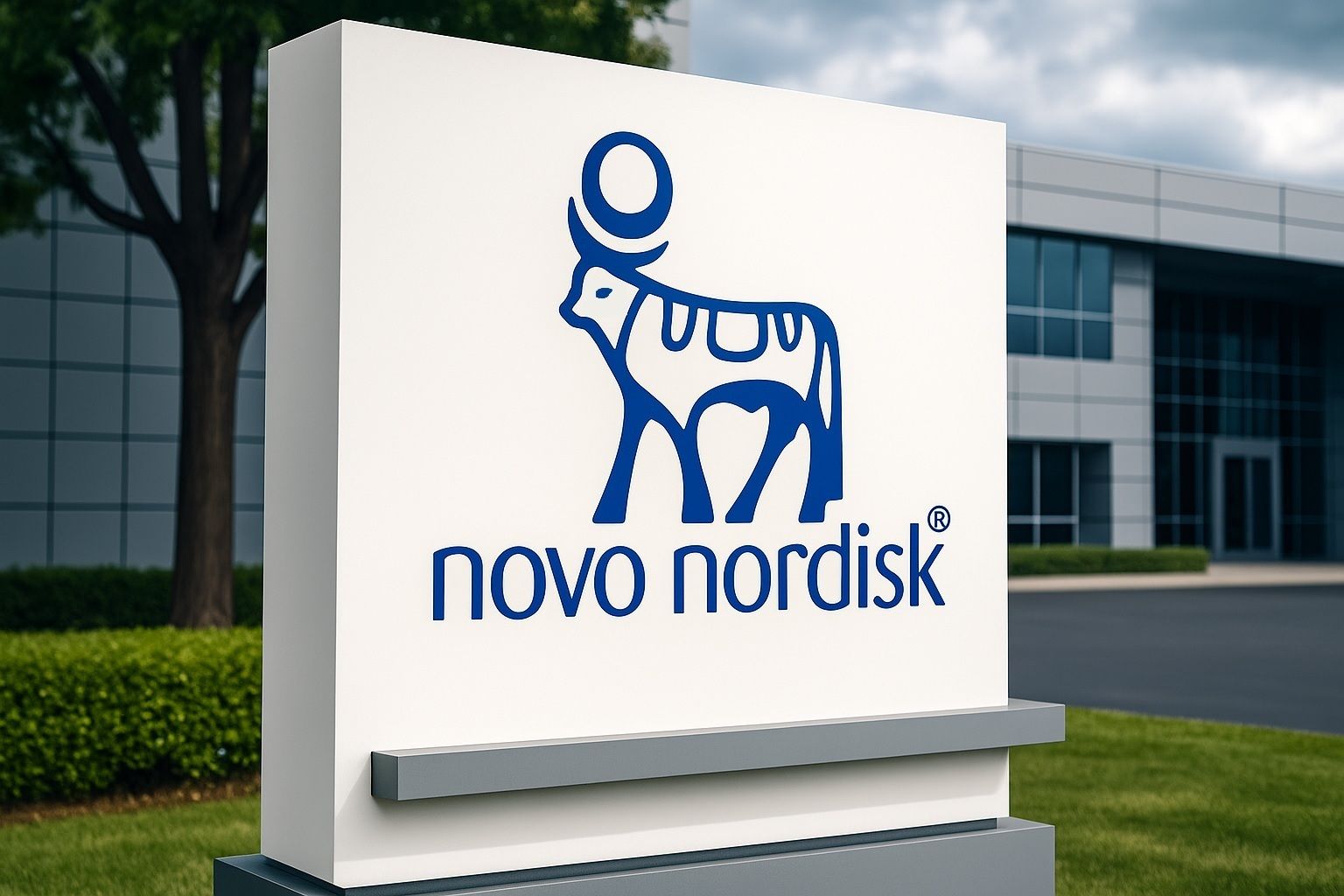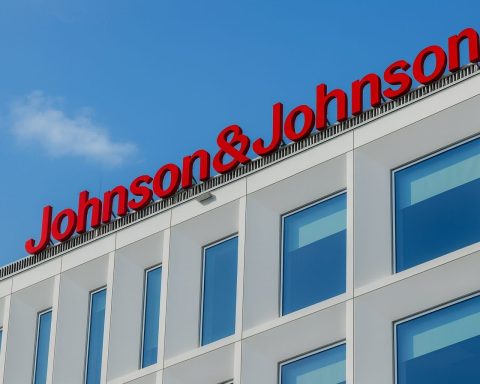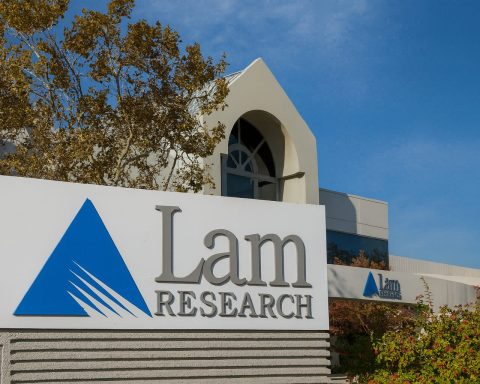- Forecast Cut Again: Novo Nordisk slashed its 2025 sales and profit growth outlook for the fourth time this year, after third-quarter results revealed slower-than-expected growth of its blockbuster weight-loss drugs Wegovy and Ozempic [1] [2].
- Q3 Misses Expectations: Third-quarter sales rose only ~5% to DKK 75.0 billion (~$11.7 billion), missing analyst forecasts of ~DKK 76 billion [3]. Wegovy revenues grew 18% year-on-year to ~DKK 20.4 billion – below expectations of ~DKK 20.9 billion [4] – while operating profit plunged ~30% (to DKK 23.7 billion) due to one-off restructuring costs [5] [6].
- Guidance Narrowed: New CEO Mike Doustdar trimmed Novo’s full-year guidance to 8–11% revenue growth (down from up to 14% prior) and 4–7% operating profit growth [7] [8], citing “lower growth expectations for our GLP-1 treatments” amid rising competition [9]. The once high-flying drugmaker is now scrambling to “compete better in dynamic and increasingly competitive markets,” Doustdar said [10] [11].
- Competition & Copycats: The Danish pharma faces intensifying competition from U.S. rival Eli Lilly’s GLP-1 drugs (such as tirzepatide, marketed as Mounjaro for diabetes and recently approved as Zepbound for obesity) which are beginning to siphon demand [12]. At the same time, cheaper “copycat” versions of Wegovy and Ozempic are being produced by compounding pharmacies in the U.S. – a practice temporarily allowed by the FDA during shortages – and Novo warns this “unsafe and unlawful mass compounding” has continued despite improved supply [13] [14].
- Pricing Pressure & Policy Moves: A slew of headwinds – including mounting pricing pressure in the U.S. – has shaken investor confidence in what was once Europe’s most valuable company [15]. Washington is pushing to lower obesity drug costs: reports say the White House is near a deal that would cap the price of Wegovy at $149 per month for the lowest dose in exchange for Medicare/Medicaid coverage [16] [17]. While expanded insurance coverage could broaden the patient pool, analysts note the ~$149 price point is a “major discount” versus global pricing, which may weigh on margins [18] [19].
- Stock Plunge & Response: Novo Nordisk’s stock has been pummeled by these challenges – shares have collapsed roughly 40–50% in 2025 alone [20] [21], wiping out much of last year’s surge when Novo briefly became Europe’s most valuable firm [22]. In response, the company is aggressively cutting costs (including 9,000 job cuts, ~11% of its workforce [23]) and doubling down on its pipeline. Novo is even outbidding Pfizer in a heated battle to acquire U.S. obesity biotech Metsera with a ~$10 billion offer – a move meant to bolster its future drug lineup [24] [25].
Once Sky-High Valuation Falters Amid Weight-Loss Drug Headwinds
Just a year ago, Novo Nordisk – buoyed by the meteoric success of its weight-loss injection Wegovy – briefly eclipsed all other European companies in market value [26]. The Danish pharmaceutical giant enjoyed surging sales as Wegovy and its type-2 diabetes sibling Ozempic (both containing the GLP-1 agonist semaglutide) became global sensations, with millions seeking their dramatic weight-loss benefits. However, 2025 has seen a sharp reversal of fortune. A “slew of headwinds has shaken investor confidence” in Novo Nordisk’s once-dominant growth story [27]. The company’s share price has plummeted nearly 50% year-to-date amid signs that demand growth is slowing and profitability is coming under pressure [28].
This abrupt shift in sentiment has been fueled by multiple challenges converging at once. Intensifying competition, pricing pressures, and even copycat drugs have combined to erode the previously sky-high expectations for Novo’s obesity franchise [29] [30]. The result: what was recently a steady success story has turned into what one analyst called a “chaotic” battle to defend Novo’s weight-loss drug leadership [31] [32]. Investors, who bid Novo’s market capitalization to record levels in 2023, are now reeling from a string of disappointing updates in 2025.
Q3 2025: Slower Growth and a “Small Miss” on Earnings
Novo Nordisk’s third-quarter 2025 earnings underscored the slowdown. Sales in Q3 grew just 5% (11% in constant currencies) to DKK 74.98 billion, coming in below consensus forecasts of around DKK 76.5 billion [33]. The growth deceleration was most pronounced in obesity treatments: Wegovy sales rose 18% globally to DKK 20.4 billion, which was weaker than analysts expected (≈DKK 20.9 billion) [34]. By contrast, Ozempic – which is primarily a diabetes therapy but widely used off-label for weight loss – saw sales climb around 9% to DKK 30.7 billion, slightly above forecasts [35] [36]. In other words, the flagship obesity drug Wegovy underperformed expectations even as overall demand remained high, suggesting competitors may be nibbling away at Novo’s growth (more on competition below).
On the profit side, Novo took a heavy hit from restructuring expenses this quarter. Operating profit fell ~30% year-on-year to DKK 23.7 billion, missing estimates (analysts expected ~DKK 24.6 billion) [37]. Net profit likewise dropped 27% to DKK 20.0 billion [38]. The steep profit decline was largely due to one-time costs – Novo booked about DKK 9 billion in charges tied to layoffs and reorganization, which weighed on the quarter’s earnings [39] [40]. Excluding those, the underlying business remained profitable, but clearly growth has moderated.
“The results amounted to a ‘small miss’ as expected,” noted one market commentator, pointing out that Novo’s sales and earnings only narrowly undershot consensus targets [41]. Indeed, some investors had braced for a weak quarter given the well-telegraphed headwinds. Still, after years of double-digit growth driven by insatiable demand for GLP-1 drugs, a mid-single-digit sales increase felt like a letdown for the market. Novo’s management acknowledged the slowdown and moved quickly to adjust expectations.
Fourth Guidance Downgrade Highlights New Reality
In conjunction with Q3 results, Novo Nordisk issued another downgrade to its full-year forecast – notably, the fourth cut to its outlook in 2025 [42]. The company narrowed its guidance ranges for both sales and profits, essentially conceding that it will not hit the ambitious growth targets set at the start of the year.
Novo now expects 2025 revenue to grow about 8%–11% (local currencies), down from a previous 8%–14% range [43]. Likewise, full-year operating profit growth is forecast at only 4%–7%, trimmed from an earlier 4%–10% outlook [44]. This guidance cut – albeit a relatively small reduction – is symbolically significant. At the start of 2025, Novo had been projecting nearly 20% profit growth; successive downgrades brought that figure down to high single digits even before Q3 [45].
New CEO Mike Doustdar explained that the reduced outlook reflects “the lower growth expectations for our GLP-1 treatments” going forward [46]. In other words, management sees the explosive growth phase of Wegovy/Ozempic waning faster than initially anticipated. Doustdar stressed that Novo must “accelerate on all fronts” to adapt to “increasingly competitive markets” in obesity care [47] [48]. The tempered forecast is an early test for Doustdar, who took the helm in August amid sky-high investor scrutiny. After all, he inherited a company whose market cap and momentum were built on these very drugs – and now he must convince stakeholders that slower growth can be overcome with strategic action.
Analysts note that even the revised guidance implies Novo’s Q4 will need to show some reacceleration to hit the low end of targets [49]. Achieving 8–11% full-year sales growth means Novo must sustain demand despite the headwinds. This sets the stage for a critical holiday quarter and a pivotal year ahead as the company implements its turnaround measures.
Competition Bites: Rival Lilly and Copycat Semaglutide Erode Growth
One major reason for Novo Nordisk’s slowing growth is fierce new competition in the weight-loss drug arena. In particular, American rival Eli Lilly has emerged as a formidable challenger. Lilly’s GLP-1 drug tirzepatide – sold as Mounjaro for diabetes – has shown powerful weight-loss effects similar to Wegovy. In late 2025, Lilly gained FDA approval to market tirzepatide specifically for obesity under the brand name Zepbound, entering direct competition with Wegovy in the weight management market. The mere anticipation of Zepbound’s launch, alongside booming off-label use of Mounjaro, has already begun to siphon some demand from Novo’s products. Novo Nordisk acknowledged that rising competition from Lilly’s treatments has “weighed on [Wegovy’s] performance” this quarter [50].
Beyond traditional competitors, unofficial copycats of Novo’s drugs are also chipping away at sales. During the past year’s Wegovy supply shortages, a number of U.S. compounding pharmacies started mixing their own versions of semaglutide (the active ingredient in Wegovy/Ozempic) and selling cheaper injections to patients. The U.S. FDA tolerated this compounding practice temporarily while authentic Wegovy was on its drug shortage list [51]. Those shortages were expected to abate by mid-2025 – and in theory, once Wegovy came off the shortage list in May, the lower-cost compounded versions should have disappeared from the market [52].
In reality, however, Novo says the practice has persisted. The company warned in its earnings statement that “unsafe and unlawful mass compounding has continued” into Q3, undercutting legitimate sales [53]. Essentially, some pharmacies are still offering unauthorized semaglutide shots, exploiting grey areas in regulation. Novo Nordisk is aggressively lobbying to stamp out these knock-offs, arguing they pose safety risks and violate its intellectual property [54] [55]. Nonetheless, as long as patients can obtain off-brand “Wegovy” for a fraction of the price, Novo’s own volumes and pricing power suffer.
The twin threats of Lilly’s sanctioned competition and compounded copycats represent a new reality for Novo. For years, the company enjoyed a near-monopoly in the nascent medical weight-loss market – demand so far outstripped supply that Novo struggled more with producing enough Wegovy than with rival encroachment. Now, the landscape is shifting: Novo Nordisk must fight to defend its market share on multiple fronts.
New CEO’s Turnaround Plan: Restructuring and Refocus
The recent setbacks have prompted a leadership shake-up and an urgent internal overhaul at Novo Nordisk. In August 2025, long-time executive Mike Doustdar was elevated to CEO after the board abruptly ousted his predecessor, who had lost investor confidence as growth sputtered [56]. Doustdar took charge with a mandate to restore momentum and “claw back lost ground in [the] fierce obesity drug market battle” [57].
One of his first moves: a sweeping restructuring initiative aimed at streamlining operations and freeing up resources for high-growth areas. In September, Novo announced plans to slash 9,000 jobs, roughly 11% of its global workforce, as part of this belt-tightening program [58]. The layoffs, among the largest in Novo’s history, are expected to reduce bureaucracy and cut costs after years of rapid expansion. They also contributed to significant one-time charges (DKK 9 billion this quarter, as noted earlier) but are projected to yield savings from Q4 onward [59].
Doustdar is also reshuffling management and the board. Several top executives and board members have been replaced to infuse fresh perspective [60]. According to Novo, these changes reflect a “renewed focus” on obesity and diabetes care – essentially recommitting the company to its core franchise while fixing execution issues [61]. “Our company-wide transformation has already driven operational efficiencies, and we have a renewed focus that can deliver a range of potential treatment options for millions more patients, mainly in obesity,” Doustdar said in the Q3 report [62]. The new CEO emphasizes that Novo must become more agile and aggressive to thrive in an “increasingly competitive” arena [63].
Another pillar of Doustdar’s strategy is expanding patient access to sustain volume growth. Novo Nordisk has been working to broaden direct-to-consumer channels in the U.S. – for example, partnering with telehealth providers to reach more patients seeking weight-loss treatments [64]. It’s also engaged in high-profile negotiations with U.S. authorities (discussed more in the next section) to potentially make its obesity drugs more affordable and covered by insurance. These efforts reflect a recognition that future growth will come not just from premium pricing, but from reaching a much larger patient population efficiently.
Overall, the internal reboot under Doustdar is still in its early stages. The Q3 results, being his first as CEO, were closely watched as a referendum on whether Novo’s course-correction is starting to pay off. While it’s too soon to see the benefits (indeed, the restructuring costs hurt this quarter’s profit), investors will be looking for signs that a leaner, refocused Novo Nordisk can return to a steady growth trajectory in 2026 and beyond.
Big Pipeline Bets: Novo, Pfizer and the $10 Billion Obesity Biotech Battle
To regain its edge, Novo Nordisk isn’t just cutting – it’s also investing boldly in the future. The company has embarked on an acquisition spree to beef up its pipeline of next-generation obesity and metabolic therapies. In fact, since Doustdar’s appointment, Novo has announced or pursued at least three major deals totaling over $17 billion to secure new drug candidates [65].
The most dramatic move is Novo’s ongoing bidding war with Pfizer over a promising U.S. obesity-drug developer called Metsera, Inc.. Pfizer initially struck a deal to buy Metsera (which is working on novel weight-loss treatments) earlier in 2025. But Novo Nordisk swooped in with a higher unsolicited bid, determined to snatch the prize from its rival. Over the past week, this corporate tug-of-war has escalated rapidly. Novo Nordisk raised its offer to about $10 billion (DKK ~70 billion), prompting Pfizer to increase its own bid as well [66] [67]. As of early November, Metsera’s board deemed Novo’s latest proposal “superior” to Pfizer’s revised offer, suggesting the Danish company may be edging closer to victory [68].
Pfizer hasn’t ceded quietly – it has filed lawsuits accusing Novo Nordisk of anticompetitive behavior in the way it intervened in the deal [69] [70]. Novo has dismissed those claims as “false and without merit” [71]. For investors, this bidding war is about more than bragging rights; it highlights how crucial pipeline depth is to dominating the obesity market long-term. Novo’s willingness to pony up $10B signals confidence that Metsera’s experimental drugs (and perhaps its scientific talent) could help sustain Novo’s growth as competition rises. However, the escalating bids also raise concerns – some analysts worry that Novo might be overpaying or stretching itself financially, especially at a time when its profit growth is narrowing [72]. Balancing strategic acquisitions against cost discipline will be a key test for management.
Metsera isn’t the only target on Novo’s radar. Recently, Novo acquired other biotech assets aimed at obesity and related diseases (for example, deals involving an NASH/liver disease drug candidate, and a partnership on a next-gen cagrilintide obesity therapy) [73]. The company appears to be assembling a broad portfolio: not just Wegovy and Ozempic, but potentially combination therapies and new mechanisms to tackle obesity from different angles. These moves are partly defensive – ensuring competitors like Pfizer or Eli Lilly don’t gain an edge – and partly offensive, aiming to extend Novo’s leadership in treating the global obesity epidemic. As Doustdar put it, Novo is “accelerating on all fronts” to “deliver a range of potential treatment options” for millions more patients [74]. In short, the battle is on to own the “future of weight-loss” medicine, and Novo is spending big to stay in the lead.
U.S. Pricing Pressures: White House Deal Could Expand Access at a Cost
Another challenge – and opportunity – looming for Novo Nordisk is the shifting policy landscape around drug pricing, especially in the United States. High prices for Wegovy (which costs over $1,300 per month at list price in the U.S.) have been a barrier for many patients and a lightning rod for political scrutiny. Unlike diabetes medications, weight-loss drugs have not been covered by Medicare, the federal insurance program for seniors, due to a statutory exclusion. That may be about to change: U.S. officials have been in talks with Novo Nordisk and Eli Lilly on ways to make these obesity drugs more affordable and accessible to patients on Medicare and Medicaid.
Multiple outlets (including The Wall Street Journal and MarketWatch) reported that the White House is close to announcing a deal with Novo and Lilly to cap the out-of-pocket cost of their weight-loss injections at $149 per month for certain patients [75] [76]. In return, Medicare and Medicaid would begin covering these drugs for eligible individuals – a huge expansion of coverage that could unlock a vast new pool of demand. According to those reports, the $149 monthly price would apply to the lowest dose of the medications, presumably as a way to make an introductory therapy affordable while higher doses could be priced differently [77]. Notably, such a price represents a deep discount (nearly 90% off the list price) in the U.S. market.
For Novo Nordisk, a government-backed deal of this nature is double-edged. On one hand, insurance coverage for obesity treatments would be a major win – it could encourage millions more patients to start therapy, knowing that Medicare/Medicaid would foot most of the bill. Volume growth could accelerate significantly if obesity drugs become broadly reimbursable. Indeed, investment bank UBS projected that Medicare inclusion would provide a “volume upside” for companies like Novo [78] [79]. On the other hand, the steep price concession (charging $149 instead of over $1,000) could compress margins in the U.S. and also set a precedent for lower pricing globally. UBS analysts described their stance on the rumored deal as “mixed” – positive on expanded coverage, but cautious that the $149 price point is a “major discount versus global obesity-drug pricing” that could undermine profitability [80] [81]. There is also uncertainty on whether this agreement might intersect with forthcoming Medicare drug price negotiations under the Inflation Reduction Act (which could impose further price limits on drugs like semaglutide down the line) [82].
From a public relations perspective, Novo Nordisk and Eli Lilly appear to be cooperating with U.S. policymakers to head off criticism that these new weight-loss drugs are only for the wealthy. By voluntarily slashing prices for government programs, the companies could gain goodwill and avoid harsher regulation, while simultaneously opening up a massive new market of insured patients. Novo’s leadership has signaled they are willing to sacrifice some short-term margin for long-term market penetration: “We aim to serve millions more patients”, Doustdar has said, highlighting the overarching goal to treat obesity at scale [83]. The exact details of any White House deal remain to be seen (as of early November 2025), but investors are watching closely. The policy outcome could profoundly shape Novo’s U.S. sales in the coming years – turning a headwind (price pressure) into a catalyst for volume growth, albeit at lower unit prices.
Market Reaction and Outlook: Cautious Optimism or More Pain Ahead?
The stream of recent news – weaker growth, guidance cuts, and strategic pivots – has made Novo Nordisk’s stock a rollercoaster for investors. After peaking in 2023, Novo’s Copenhagen-listed shares have lost roughly half their value in 2025 [84], a stunning reversal for a company that was, until recently, a market darling. Each downgrade and competitive threat added to the sell-off. “Investors have punished the stock,” as one outlet plainly put it, in light of the slew of challenges hitting the business [85] [86].
However, there are signs that market sentiment may be stabilizing as Novo takes action. When the Q3 results and guidance cut were announced on November 5, the stock initially slumped in early trading – a knee-jerk reaction to the downbeat outlook – but then rebounded to positive territory later in the day [87]. This suggests that much of the bad news had already been priced in, and perhaps some investors saw the post-earnings dip as a buying opportunity given Novo’s still-strong fundamentals. Indeed, despite the near-term hurdles, Novo Nordisk remains a highly profitable company with a dominant position in a huge and growing therapeutic area (global obesity/diabetes). Some market watchers argue that the recent sell-off was overdone. Prior to earnings, one investment firm highlighted Novo’s excellent earnings yield and return on capital, calling those metrics “attractive” and expressing confidence in the company’s long-term profitability [88]. Such analyses imply that once the current storm passes, Novo could regain its footing.
Wall Street analysts are somewhat divided but generally see upside potential. The consensus rating on Novo’s stock is still “Buy”, and the average 12-month price target for the U.S.-listed shares is around $80 (equivalent to roughly 540 Danish kroner) [89] [90] – significantly above the current trading level near $50 (≈330 kroner). UBS, for example, rates the stock Neutral with a price target of DKK 340, acknowledging near-term uncertainty but not bearish on Novo’s prospects [91]. The bull case is that Novo Nordisk can work through temporary setbacks (like supply issues and retooling production) and still capitalize on enormous demand for effective weight-loss treatments worldwide. The global obesity epidemic is far from addressed, and Novo’s early mover advantage, broadening portfolio, and manufacturing scale could translate into years of solid growth if managed well.
Of course, risks remain. Eli Lilly’s ascendancy in obesity care means Novo will likely never again enjoy the quasi-monopoly conditions it had in 2021–2022. Competition could intensify further if more entrants (possibly Pfizer via Metsera, or others) bring new weight-loss drugs to market in coming years. Pricing pressures from governments and insurers are likely to increase rather than abate as these drugs become more mainstream. Novo Nordisk will need to execute its “accelerate on all fronts” game plan deftly – trimming costs, innovating new therapies, and expanding access – to maintain robust earnings growth under these conditions.
For now, the company’s management appears resolute. “We aim to compete better” in a dynamic market, Doustdar has affirmed [92]. Novo’s dramatic rise and recent stumble illustrate both the vast potential and the volatility inherent in the modern race to tackle obesity. The coming quarters will reveal whether this Danish pharma giant can resume its winning streak or if further growing pains are in store. Either way, with tens of billions of dollars and the health of millions of patients on the line, all eyes remain on Novo Nordisk as it navigates the next phase of the weight-loss drug revolution.
Sources:
- Dominic Chopping, Dow Jones Newswires/WSJ: “Ozempic Maker Novo Nordisk Lowers Growth Outlook of Its Blockbuster Drugs” [93] [94]
- Jacob Gronholt-Pedersen & Maggie Fick, Reuters: “Novo Nordisk lowers full-year profit guidance in new CEO’s maiden quarter” [95] [96]
- Naomi Kresge, Bloomberg: “Novo Cuts Outlook Once Again, Highlighting Obesity Struggles” [97] [98]
- CNBC News: “Ozempic maker Novo Nordisk lowers growth outlook for its weight loss drugs as pricing pressures mount” [99] [100]
- Deepti Sri, Stocktwits News: “Can Novo Nordisk’s ‘Attractive’ Fundamentals Outweigh Slowing Wegovy Sales And a $149 Price Cap?” [101] [102]
- Novo Nordisk Q3 Earnings Release and Investor Call (November 5, 2025) – Company financial report and statements [103] [104]
References
1. www.bloomberg.com, 2. stocktwits.com, 3. www.reuters.com, 4. www.reuters.com, 5. www.reuters.com, 6. www.reuters.com, 7. www.reuters.com, 8. www.reuters.com, 9. www.reuters.com, 10. www.reuters.com, 11. www.reuters.com, 12. stocktwits.com, 13. www.reuters.com, 14. www.marketscreener.com, 15. stockanalysis.com, 16. www.marketscreener.com, 17. stocktwits.com, 18. stocktwits.com, 19. stocktwits.com, 20. www.reuters.com, 21. stocktwits.com, 22. www.reuters.com, 23. www.marketscreener.com, 24. stocktwits.com, 25. stocktwits.com, 26. www.reuters.com, 27. stockanalysis.com, 28. www.reuters.com, 29. stocktwits.com, 30. www.reuters.com, 31. stockanalysis.com, 32. stockanalysis.com, 33. www.reuters.com, 34. www.reuters.com, 35. www.marketscreener.com, 36. www.marketscreener.com, 37. www.reuters.com, 38. www.marketscreener.com, 39. www.marketscreener.com, 40. www.marketscreener.com, 41. stocktwits.com, 42. www.bloomberg.com, 43. www.reuters.com, 44. www.reuters.com, 45. www.marketscreener.com, 46. www.reuters.com, 47. www.reuters.com, 48. www.reuters.com, 49. www.reuters.com, 50. stocktwits.com, 51. www.marketscreener.com, 52. www.marketscreener.com, 53. www.reuters.com, 54. www.marketscreener.com, 55. www.marketscreener.com, 56. www.marketscreener.com, 57. www.reuters.com, 58. www.marketscreener.com, 59. www.marketscreener.com, 60. www.marketscreener.com, 61. www.marketscreener.com, 62. www.marketscreener.com, 63. www.reuters.com, 64. www.marketscreener.com, 65. www.marketscreener.com, 66. stocktwits.com, 67. stockanalysis.com, 68. stocktwits.com, 69. stocktwits.com, 70. stocktwits.com, 71. stocktwits.com, 72. stocktwits.com, 73. www.marketscreener.com, 74. www.marketscreener.com, 75. www.marketscreener.com, 76. stocktwits.com, 77. www.marketscreener.com, 78. stocktwits.com, 79. stocktwits.com, 80. stocktwits.com, 81. stocktwits.com, 82. stocktwits.com, 83. www.marketscreener.com, 84. www.reuters.com, 85. ground.news, 86. ground.news, 87. www.bloomberg.com, 88. stocktwits.com, 89. stockanalysis.com, 90. stockanalysis.com, 91. stocktwits.com, 92. www.reuters.com, 93. www.marketscreener.com, 94. www.marketscreener.com, 95. www.reuters.com, 96. www.reuters.com, 97. www.bloomberg.com, 98. www.bloomberg.com, 99. stockanalysis.com, 100. stockanalysis.com, 101. stocktwits.com, 102. stocktwits.com, 103. www.reuters.com, 104. www.reuters.com







